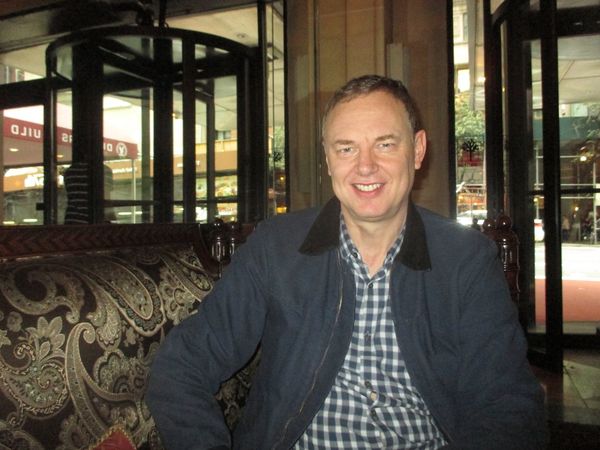Max Ophüls' The Earrings Of Madame De…, starring Danielle Darrieux, Charles Boyer, and Vittorio De Sica, Guy de Maupassant, the Eiffel Tower, Orson Welles's Citizen Kane, and François Truffaut, the reflected relationship between Dominic West's Willy and Keira Knightley's Colette, and the influence of Kiyoshi Kurosawa's Cure on Earthquake Bird, starring Alicia Vikander, Riley Keough, and Jack Huston, adapted from Susanna Jones's novel - all come up in the final instalment of my conversation with Colette director Wash Westmoreland at Le Parker Meridien in New York.
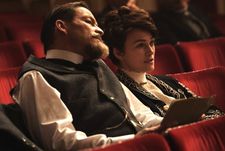 |
| Wash Westmoreland on Willy (Dominic West) taking credit for Colette's (Keira Knightley) work: "Like in West Side Story, Natalie Wood's voice was sung by someone else." |
On December 13th, Keira Knightley was appointed Officer of the Order of the British Empire for 'services to Drama and charity'.
Anne-Katrin Titze: The new inventions of the era show up in your film Colette: The first electric light in the building. And there is a link to both Truffaut and Citizen Kane - the Eiffel Tower in the snow globe.
Wash Westmoreland: Snow globes had only been invented in 1889. So it would have been the first time that she'd seen a snow globe. With the Eiffel Tower.
AKT: Which was being built at the time!
WW: Which had just been completed. And Willy calls it a "grand erection in the center of our capitol, of course I'm jealous." Comparing it to his own phallus, which is something like a phrase that Guy de Maupassant [Jean Renoir's A Day In The Country] used. There was a protest against the Eiffel Tower signed by artists and Guy de Maupassant was one of the most vocal people against it.
And it was described as "a giant erection in the centre of our city." Colette takes it and she turns it upside down. Later in the story when her marriage is on the wane and Willy's declining into impotency, they find the Eiffel Tower snow globe and the water is drained out and it looks very sad.
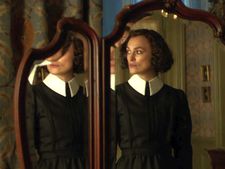 |
| Wash Westmoreland on Colette (Keira Knightley): "The mirrors reflect often what Colette is focusing on." |
And a tie-in with Citizen Kane because he was like Charles Foster Kane. He controlled culture. He had his own ideas and this force of personality to project them into the public domain and the wealth and privilege of male power. And the scene where in Citizen Kane all the dancing girls appear from nowhere - that's what we also have in Colette when Willy basically raps this poem about Colette and we have this big table and, oh, wouldn't it be great if everyone just started dancing on the table. We figured that out pretty much last minute.
The technologies are very interesting. You go from horse-drawn carriage to motor cars and we make a point of it and that happens in the sound design. Even when they are in rooms in their own house, initially you hear horses clip-clopping down the street. By the end it's motor cars. The way she writes, initially it's a pen that's dipped in ink. By the end it's a fountain pen that doesn't need dipping anymore.
The invention of electric light was not just a sudden changeover but it happened according to class and location. Paris would have been electrified before the country, obviously, but rich people's buildings were electrified individually. Like, they'd have a generator in the basement.
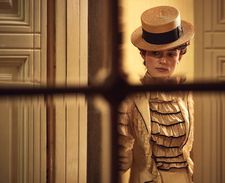 |
| Wash Westmoreland on Colette (Keira Knightley): "The way she writes, initially it's a pen that's dipped in ink. By the end it's a fountain pen that doesn't need dipping anymore. " |
So Madame De Caillavet [Arabella Weir] is the first to get electricity. And there's a moment when Colette and Willy after their successful launch of a Claudine play come in and she flicks the light switch on and you realise - oh they jumped social set with the success of the Claudines.
AKT: The other thought, besides Citizen Kane, was to François Truffaut - who collected Eiffel Towers.
WW: Oh, I didn't know that!
AKT: He [Truffaut] was an avid collector and all over his films you see little Eiffel Towers placed in the sets. I liked how you start the movie with the cat and bird sounds - setting it up right away, the question, who is the cat? And who is the bird? It's such a beautiful shot with the mother and the cat in the mirror. The first of many mirrors.
WW: The mirrors reflect often what Colette is focusing on. Initially her mother appears in the mirror. Later on she's in the mirror, trying on a dress for the party but it's like the dress that Willy has put her in. That she's uncomfortable in? Later on we see her in the mirror where she is rehearsing her mime exercises with Wague [Dickie Beau] and she's connecting to herself finally.
Near the end of the movie, where she's in the dressing room, she looks in the mirror and picks up a pen and finally starts writing in her own voice. It's this evolution of concepts of self.
 |
| Colette (Keira Knightley) with her lover Missy (Denise Gough) |
AKT: The mirror phase - entering into the Symbolic Order, in the name of the father. You could throw all of these thoughts into the mix as well.
WW: There's a lot of frames as well. Because we were very influenced by Max Ophüls' The Earrings Of Madame De... There's a lot of shots in the salon that follow, that kind of follow her through the salon. And a lot of internal light windows in the apartment were common in bourgeois apartments around the turn of the century before electricity, which allowed daylight to get into dark recesses.
AKT: Right, that's why French doors are called French doors.
WW: They provide great cinematic devices. Also to frame Colette while she's writing. You see her through that window so she's contained. And Willy.
AKT: Always framed, or there's always an attempt to frame. Until she breaks out.
WW: And there's always the little statue of Willy. Which is a real thing too, that he made statues of himself. Framed pictures of himself.
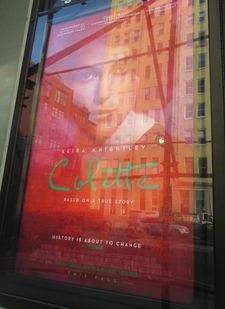 |
| Colette poster - opens in the UK on January 11, 2019 Photo: Anne-Katrin Titze |
AKT: Just take the name!
WW: I know, everything about him. If he was on a magazine cover he would frame it and have it in his study which is very much like someone we know, who is President of the United States right now.
AKT: Also, not letting someone get what they deserve for the work they've done, that's also Singin' In The Rain.
WW: Right.
AKT: Keep singing without getting credit for it. That is also part of cinema.
WW: Like in West Side Story, Natalie Wood's voice was sung by someone else.
AKT: You have to stay in the shadows. You cannot put your name to it.
WW: In the salon we have the mime. Before pantomime was 'cantomime', which was basically lip-synching. It was like RuPaul's Drag Race but in like 1895. You see him lip-synching to a woman singing. Which again was a metaphor for what's going on with Colette and Willy but also really interesting insight into the culture of the salons. These kind of entertainments were very cutting-edge.
AKT: Your next film is far away from the Belle Époque, I suspect?
WW: I've already shot another film. I was in Tokyo this year for five months, working on a project called The Earthquake Bird. It's a Tokyo noir. It's a crime story.
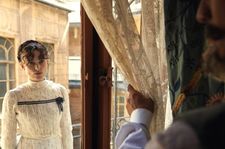 |
| Wash Westmoreland shows Willy (Dominic West) containing Colette (Keira Knightley) by framing her |
AKT: Based on a novel?
WW: Based on a novel by Susanna Jones, a British author, about a young woman living in Japan in 1989 who gets involved in a murder investigation.
AKT: Birds, earthquakes, and Japan - the first author that came to my mind was [Haruki] Murakami. This has nothing to do with him?
WW: It was kind of influenced by classic Japanese noirs, Kurosawa, but also some of the Nineties Japanese neo-noirs. Kiyoshi Kurosawa's movie Cure. That was a big influence. It's a police procedural but with certain paranormal elements that may or may not be real. And we wanted to create a similar tone for this.
Read what Wash Westmoreland had to say on Richard Glatzer, costume designer Andrea Flesch, nature, and the relationships in Colette.
Read what Wash Westmoreland had to say on La Belle Époque, Keira Knightley's Colette, Dominic West's Willy, and Dickie Beau's Wague in Colette.
Colette opens in the UK on January 11, 2019.








